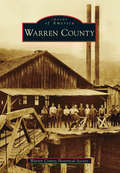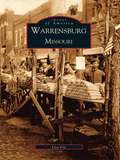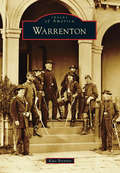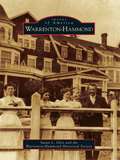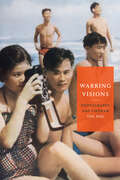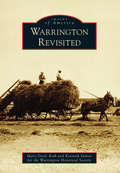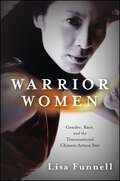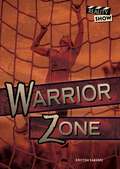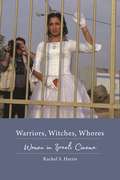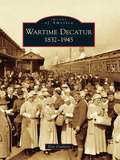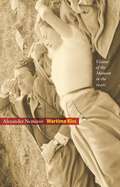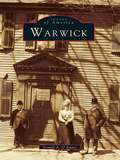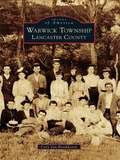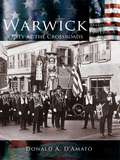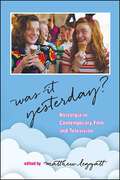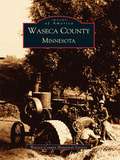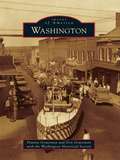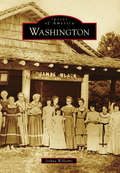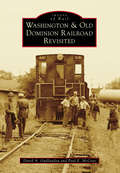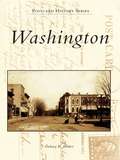- Table View
- List View
Warren County
by Warren County Historical SocietyWarren County's townships, nestled in the northwest corner of Pennsylvania, were originally formed from the land grants awarded by William Penn and his descendants to many individuals and families. Warren County was established March 12, 1800, and grew in prosperity from agriculture, lumber, oil, rafting, railroads, and tanning. The Allegheny National Forest and Allegheny River both provide magnificent arenas for many local recreational and business opportunities. In 1965, Warren County became home to the Kinzua Dam as the flooding of Corydon and parts of Kinzua Township created the reservoir. While most of the eastern and southern parts of the county are broken and hilly, the northeastern section is mostly glacial territory. Hearts Content in Watson Township is one of the few virgin timber tracts remaining in the Allegheny National Forest.
Warrensburg, Missouri
by Lisa IrleWarrensburg, Missouri, was destined to be more than a one-horse town. When Martin Warren set up his blacksmith shop in 1833, the farmers who gathered there to have their horses shod became the community's first citizens. The town was later named in honor of Warren. During the Civil War, Warrensburg hosted both Union and Confederate troops, who reportedly drilled on the same parade grounds. When the railroad reached Warrensburg on July 4, 1864, the frontier town began to thrive, eventually achieving success in agriculture and, since 1871, in higher education.Warrensburg, Missouri illustrates the history of the city in more than 200 vintage images, detailing the faces, places, and events that have colored the town. The "healing waters" of Pertle Springs drew visitors from all around, and in 1870, Warrensburg would be made famous by a trial concerning a slain hunting dog, Old Drum.
Warrenton (Images of America)
by Kate BrennerWhen Warrenton was founded in the 18th century, it was nothing more than a dusty road and watering hole. It served as a tavern and courthouse for weary travelers on the Falmouth-Winchester and Alexandria-Culpeper roads. As it grew and became the seat of Fauquier County, it was transformed into a magnet for judges and lawyers--many of whom shaped the country's government after the Revolutionary War. Almost a century later, Warrenton changed hands more than 60 times during the Civil War; it experienced Reconstruction and rose from the ashes after a great fire that wiped out almost half the town. Today, it has become an epicenter for equestrians, serving as home to foxhunters, the Virginia Gold Cup Steeplechase, and the Warrenton Horse Show. With vintage photographs, Warrenton beckons readers back in time, along the backdrop of beautiful 18th- and 19th-century architecture and estates, to remember the spirit of a bygone era that still paints the streets and colors the culture of the people who live there.
Warrenton-Hammond (Images of America)
by Warrenton-Hammond Historical Society Susan L. GlenLocated near the mouth of the Columbia River, Warrenton, incorporated in February 1899, is a city comprised of many earlier towns and villages. Hammond, although still having a separate post office and zip code, was merged with Warrenton in 1991. Fort Stevens, now an Oregon State Park, is located near Hammond. Lexington was the first county seat for Clatsop County until the county seat was vacated on December 4, 1879, and moved to Astoria. Skipanon, located near the same site as Lexington, was also annexed by Warrenton. Flavel, along the Columbia River between Warrenton and Hammond, was an active port for the Great Northern Steamship Company. It was annexed by Warrenton in 1918. Warrenton-Hammond documents each of these towns as they grew and became the present city of Warrenton.
Warring Visions: Photography and Vietnam
by Thy PhuIn Warring Visions, Thy Phu explores photography from dispersed communities throughout Vietnam and the Vietnamese diaspora, both during and after the Vietnam War, to complicate narratives of conflict and memory. While the visual history of the Vietnam War has been dominated by American documentaries and war photography, Phu turns to photographs circulated by the Vietnamese themselves, capturing a range of subjects, occasions, and perspectives. Phu's concept of warring visions refers to contrasts in the use of war photos in North Vietnam, which highlighted national liberation and aligned themselves with an international audience, and those in South Vietnam, which focused on family and everyday survival. Phu also uses warring visions to enlarge the category of war photography, a genre that usually consists of images illustrating the immediacy of combat and the spectacle of violence, pain, and wounded bodies. She pushes this genre beyond such definitions by analyzing pictures of family life, weddings, and other quotidian scenes of life during the war. Phu thus expands our understanding of how war is waged, experienced, and resolved.
Warrington Revisited (Images of America)
by Kenneth Samen Mary Doyle Roth Warrington Historical SocietyAt the time of Warrington Township's founding in 1734, few landowners lived on Bucks County's fertile soil. The history of the township is one of gradual growth and development. From unbroken wilderness grew small clusters of families forming villages. Warrington consisted of four villages: Warrington, Neshaminy, Pleasantville, and Tradesville. In the mid-1800s, the township's landscape was made up of family farms, with agriculture as the main industry. In the late 1920s, the first small housing developments were built. By the early 1960s, larger housing developments and shopping centers had replaced many farms. Once lined with lush fields of crops and trees, the Doylestown-Willow Grove Turnpike/Easton Road/Route 611 has seen the most change throughout time. Historically significant families, including the Barnesses, Coggiolas, Cornells, Craigs, Holberts, Leventhals, Mayers, Pauls, Penroses, Wileys, and Worthingtons, created well-known businesses along this road on which they lived. Today, this thoroughfare has little historic substance to offer its current residents.
Warrior Genius
by Michael Dante DiMartinoIn Warrior Genius, author Michael Dante DiMartino delivers rich settings, memorable characters, and edge-of-your-seat action, just as he did in his hit animated show Avatar: The Last Airbender. Fans will be thrilled with this new adventure!For years, Supreme Creator Nerezza has used fear and violence to rule her empire, seeking to eradicate anyone with a Genius. Then, twelve-year-old Giacomo emerged from hiding and joined a young generation of fellow artists paired with Geniuses. Together, they began a rebellion against her.Now, Giacomo has something Nerezza desperately wants—the Compass, one of three powerful objects known as the Sacred Tools. Possessing all three would allow Nerezza to spread her tyranny worldwide.After a near-fatal showdown, Giacomo and his friends escape to the empire of Rachana, a society long feared for its mighty warriors and their horse-Geniuses. But a dark and ancient force threatens the horse-Geniuses with extinction, and Giacomo discovers he is the only one who can stop it.With the help of his Genius and great friends, Giacomo struggles to keep the Sacred Tools from falling into the wrong hands and find a way to protect the Rachanan people—before Nerezza finds him.
Warrior Women: Gender, Race, and the Transnational Chinese Action Star
by Lisa FunnellFinalist for the 2014 ForeWord IndieFab Book of the Year Award in the Women's Studies CategoryBronze Medalist, 2015 Independent Publisher Book Awards in the Women Issues CategoryWinnerof the 2015 Emily Toth Award presented by the Popular Culture Association & American Culture AssociationWarrior Women considers the significance of Chinese female action stars in martial arts films produced across a range of national and transnational contexts. Lisa Funnell examines the impact of the 1997 transfer of Hong Kong from British to Chinese rule on the representation of Chinese identities—Hong Kong Chinese, mainland Chinese, Chinese American, Chinese Canadian—in action films produced domestically in Hong Kong and, increasingly, in cooperation with mainland China and Hollywood. Hong Kong cinema has offered space for the development of transnational Chinese screen identities that challenge the racial stereotypes historically associated with the Asian female body in the West. The ethnic/national differentiation of transnational Chinese female stars—such as Pei Pei Cheng, Charlene Choi, Gong Li, Lucy Liu, Shu Qi, Michelle Yeoh, and Zhang Ziyi—is considered part of the ongoing negotiation of social, cultural, and geopolitical identities in the Chinese-speaking world.
Warrior Zone (Reality Show)
by Kristen SaBerreWhen Fiona enters a physical feats TV competition, she is excited to see how she matches up against other athletes from around the country. She works hard and beats out many of her competitors. But when she reaches the final round, she finds that the show has been rigged all along. The producers take her off-screen to tell her that one of the other contestants has been chosen to win and that she needs to pretend to lose—or she won't win any money. Fiona must choose between competing fairly or playing by the producers' rules.
Warriors, Witches, Whores: Women in Israeli Cinema
by Rachel S. HarrisWarriors, Witches, Whores: Women in Israeli Cinema is a feminist study of Israel’s film industry and the changes that have occurred since the 1990s. Working in feminist film theory, the book adopts a cultural studies approach, considering the creation of a female-centered and thematically feminist film culture in light of structural and ideological shifts in Israeli society. Author Rachel S. Harris situates these changes in dialogue with the cinematic history that preceded them and the ongoing social inequalities that perpetuate women’s marginalization within Israeli society. While no one can deny Israel’s Western women’s advancements, feminist filmmakers frequently turn to Israel’s less impressive underbelly as sources for their inspiration. Their films have focused on sexism, the negative impact of militarism on women’s experience, rape culture, prostitution, and sexual abuse. These films also tend to include subjects from society’s geographical periphery and social margins, such as female foreign workers, women, and refugees. Warriors, Witches, Whoresis divided into three major sections and each considers a different form of feminist engagement. The first part explores films that situate women in traditionally male spheres of militarism, considering the impact of interjecting women within hegemonic spaces or reconceptualizing them in feminist ways. The second part recovers the narratives of women’s experience that were previously marginalized or silenced, thereby creating a distinct female space that offers new kinds of storytelling and cinematic aesthetics that reflect feminist expressions of identity. The third part offers examples of feminist activism that reach beyond the boundaries of the film to comment on social issues, particularly those which affect women. This section demonstrates how feminists use film (and work within the film industry) in order to women’s position in society. While there are thematic overlaps between the chapters, each section marks structural differences in the modes of feminist response. Warriors, Witches, Whores considers the ways social and political power have impacted the representation of women and looks to how feminist filmmakers have fought against these inequities behind the camera, in the stories they tell, and in the ways women are depicted on screen. Students and scholars of film, gender, or cultural studies will appreciate this approachable monograph.
Wartime Decatur: 1832-1945 (Images of America)
by Dan GuilloryDecatur has a long history of patriotic service, both on and off the field of battle. Decatur volunteers participated in six major campaigns including the Black Hawk War (1832), the Mexican War (1846-1848), the Civil War (1861-1865), the Spanish-American War (1898), World War I (1917-1918), and World War II (1941-1945). Their record of distinguished service includes the presence of five generals and six Congressional Medal of Honor winners in the Civil War. The Grand Army of the Republic (GAR), the first national veterans' organization, was founded in Decatur immediately after the Civil War. In World War II, soldiers from Decatur served in North Africa, Italy, the Philippines, and Germany. Equally impressive, however, is the tradition of the Decatur Canteen, which served food to transient soldiers from the time of the Civil War onward. Local volunteers rolled bandages, collected food, and recycled bales of paper and heaps of scrap metal. Citizens planted victory gardens and bought war bonds and savings stamps. Wartime Decatur: 1832-1945 documents the vigorous wartime culture based on community involvement and a strong sense of patriotism.
Wartime Kiss: Visions of the Moment in the 1940s (Essays in the Arts)
by Alexander NemerovA deeply personal meditation on the haunting power of American photos and films of the 1940sWartime Kiss is a personal meditation on the haunting power of American photographs and films from World War II and the later 1940s. Starting with a stunning reinterpretation of one of the most famous photos of all time, Alfred Eisenstaedt's image of a sailor kissing a nurse in Times Square on V-J Day, Alexander Nemerov goes on to examine an array of mostly forgotten images and movie episodes—from a photo of Jimmy Stewart and Olivia de Havilland lying on a picnic blanket in the Santa Barbara hills to scenes from such films as Twelve O'Clock High and Hold Back the Dawn. Erotically charged and bearing traces of trauma even when they seem far removed from the war, these photos and scenes seem to hold out the promise of a palpable and emotional connection to those years.Through a series of fascinating stories, Nemerov reveals the surprising background of these bits of film and discovers unexpected connections between the war and Hollywood, from an obsession with aviation to Anne Frank's love of the movies. Beautifully written and illustrated, Wartime Kiss vividly evokes a world in which Margaret Bourke-White could follow a heroic assignment photographing a B-17 bombing mission over Tunis with a job in Hollywood documenting the filming of a war movie. Ultimately this is a book about history as a sensuous experience, a work as mysterious, indescribable, and affecting as a novel by W. G. Sebald.
Warwick
by Donald A. D’amatoIncorporated in 1931, the city of Warwick has nevertheless supported and influenced the economy and culture of Rhode Island in many important ways for far longer. Home to prosperous and dynamic mills since the nineteenth century, Warwick provided employment to locals and attracted a diverse community of newcomers. Developments in transportation led to the rise of seaside recreation at Oakland Beach and Rocky Point, creating memories cherished even today.
Warwick Township, Lancaster County (Images of America)
by Cory Van BrookhovenWarwick Township was one of the original townships of Lancaster County. The area was first settled by Richard Carter from Warwickshire, England, and as families grew within its borders, several villages started to come to life. Industries such as blacksmithing, an iron foundry and wagon factory, numerous cigar manufacturers, farms and dairies, mills, and other early businesses helped to shape the township's economic growth. As time passed, transportation evolved from horse-drawn carriages to the automobile. The Reading and Columbia Rail Road, along with Conestoga Traction Company's trolley service, also played a vital part in mass transportation. Today Warwick Township is known for its scenic beauty, rich history, and hardworking residents.
Warwick: A City at the Crossroads
by Donald A. D'AmatoAlthough known as the retail capital of Rhode Island, Warwick is much more than a conglomeration of shopping centers, malls, and industrial parks; it is a city marked by an extraordinary history and in many ways, serves as a mirror of the American experience. Like many communities across the United States, Warwick developed from a rural hamlet into a town distinguished by a variety of industries in the nineteenth century, attracting immigrants from across the globe desiring a new beginning within its mill villages. These industries brought wealth and opportunity, and paved the way for Warwick's transformation from small town to cosmopolitan center. Warwick: A City at the Crossroads is not a stale chronology, but is a work that breathes new life into the memorable characters and events that shaped the community's history over the past four centuries. Taking readers on an exciting journey through Warwick's past, this unique illustrated history begins with the first Narragansett Indian tribes that hunted amidst the virgin wilderness and details an evolving landscape touched by colonial settlement, wars, storms, depressions, resort development, and industrialization up through the present day. However, the true measure of a community is in its people, and Warwick possesses a remarkable cast of colorful characters, such as controversial city father, Samuel Gorton, Revolutionary War heroes Nathanael Greene and James Varnum, textile magnate Robert Knight, and scores of other distinct personalities, ranging from privateers and bootleggers to feared political bosses and industrial giants.
Was It Yesterday?: Nostalgia in Contemporary Film and Television (SUNY series, Horizons of Cinema)
by Matthew LeggattBringing together prominent transatlantic film and media scholars, Was It Yesterday? explores the impact of nostalgia in twenty-first century American film and television. Cultural nostalgia, in both real and imagined forms, is dominant today, but what does the concentration on bringing back the past mean for an understanding of our cultural moment, and what are the consequences for viewers? This book questions the nature of this nostalgic phenomenon, the politics associated with it, and the significance of the different periods, in addition to offering counterarguments that see nostalgia as prevalent throughout film and television history. Considering such films and television shows as La La Land, Westworld, Stranger Things, and American Hustle, the contributors demonstrate how audiences have spent more time over the last decade living in various pasts.
Waseca County, Minnesota
by Waseca County Historical SocietyWaseca County, Minnesota, is comprised of a number of unique communities-Alma City, New Richland, Waldorf, Otisco, Janesville, Palmer, and the county seat of Waseca-each adding to the county's rich history and remarkable scenic beauty. The county can boast of nine architectural gems on the National Register of Historic Sites. These distinctive landmarks include the Richardsonian Romanesque-style Waseca County Courthouse, the Greek Revival-style Janesville Public Library, and the Gothic Revival-style Vista Lutheran Church in Otisco Township. Historic houses include the P.C. Bailey House, built in 1868 and one of Waseca's oldest homes, as well as the R. Percy Ward House, home to one of the area's most prominent turn-of-the-century businessmen.With over 200 vintage photographs Waseca County showcases not only the buildings and businesses of this historic county, but also the people who helped contribute to its growth and prosperity, people whose devotion to education, history, and a sense of community continues to grow.
Wash Day: Passing on the Legacy, Rituals, and Love of Natural Hair
by Tomesha FaxioA visual celebration of natural Black hair that highlights the powerful connection between mothers and their children during their wash day rituals. &“A beautiful love letter to natural hair and the rituals Black women have created.&”—Roxane GayIn this stunning book, documentary photographer Tomesha Faxio explores the power of &“wash day,&” a day that Black women dedicate to washing, detangling, conditioning, and styling their natural hair. The significance of wash day goes far beyond hair care—it&’s an opportunity for Black women to pour love into their curly, coily locks and, when they have children, pass on this sacred ritual to the next generation. Wash Day celebrates the unique bonds between Black mothers and their children through intimate photographs of their hair-care routines and insightful stories that detail their natural hair journeys. Faxio brings you into the homes of twenty-six different families, illustrating the many ways that these mothers have used wash day to instill love, acceptance, and confidence in their children about wearing their natural hair. Through hours spent with their children, typically at the kitchen sink, each of these mothers is resisting generations of hair discrimination by creating a space for empowerment, all while finding their own sense of self-acceptance along the way. Capturing the inherent beauty and diversity of natural hair, Wash Day is a visual homage to Black culture, Black rituals, and the generational bonds that strengthen the Black community.
Washed Ashore: Art to Save the Sea (Fountas & Pinnell Classroom, Guided Reading)
by Alicia FenwickNIMAC-sourced textbook. TURNING TRASH INTO ART. Too much trash ends up on beaches and in the ocean. The trash is ugly and it hurts sea animals. One group is doing something about it.
Washi Tape Christmas: Easy Holiday Craft Ideas with Washi Tape
by Kami BiglerWith such a massive range of festive patterns and designs in the craft stores, crafting with washi tape at Christmas is the ultimate joy of the season! In this super collection of over 30 simple craft projects, author Kami Bigler of "NoBiggie" blog fame, shows you how to use washi tape in an array of ways to create fun and festive makes for the holidays. With quick and clever Christmas cards, pretty paper ornaments, embellished gifts, cute decorations, creative wrapping ideas and more, Washi Tape Christmas offers a wealth of creativity to get you crafting this Christmas.
Washi Tape Crafts: 110 Ways to Decorate Just About Anything
by Amy AndersonIt’s the definitive washi tape craft book for adults. Washi tape—the Japanese decorative paper tape that’s easy to tear, peel, stick and re-stick—is transformative, fun, and remarkably easy to use. It’s also never been hotter. Packed full of amazing projects and ideas, it’s the book and tape kit that shows all the ways to be creative with washi tape. The book includes techniques: precision tearing, wrapping, and weaving. How to make bows, rosettes, and other shapes. How to seal and weatherproof designs to make them permanent. And 110 projects, with color photographs and step-by-step instructions, from custom photo frames to one-of-a-kind gifts. The possibilities are endless.
Washington
by Washington Historical Society Don Graveman Dianna GravemanWashington Landing, as the settlement was called in the early 1800s, was a popular river port along the Missouri River. Many German immigrants were attracted to the rolling hills and valley reminiscent of their homeland, and other settlers saw potential as well. The settlement grew quickly, and by the time the town of Washington was officially established in 1839, it was the most prosperous town in Franklin County. John B. Busch established a brewery in Washington in 1854 and produced the first Busch Beer. Franz Schwarzer began manufacturing what would become his world-famous zither (a German, stringed musical instrument) in 1866. Henry Tibbe began making corncob pipes around 1869, and Washington later became known as the "Corncob Pipe Capital of the World." Today Washington holds the state record for the most buildings on the National Register of Historic Places and hosts four museums, including the Missouri Photojournalism Hall of Fame. Nestled in the heart of Missouri wine country, Washington draws thousands of visitors to the area each year.
Washington
by Joshua WilliamsLocated on the Southwest Trail that connected St. Louis to Texas, the town of Washington was established in 1824 in the southwest corner of Arkansas. Named after the first president of the United States, Washington is an example of a true American town with the city streets bearing the names of famous countrymen. American icons such as James Bowie, Sam Houston, and Davy Crockett all passed through this unique community. One of its citizens, a local blacksmith, made a knife for Bowie, which became infamously known as the Bowie Knife. During the last two years of the Civil War, Washington became the capital of the Confederate government of Arkansas. In later years, it was bypassed by the railroad, and the town faced decline. In the 20th century, concerned citizens pushed for its restoration, and today Washington consists of a state park that continues to tell the story of this unique community to future generations.
Washington & Old Dominion Railroad Revisited (Images of Rail)
by David A. Guillaudeu Paul E. MccrayWashington & Old Dominion Railroad covered therailroad's corporate history, construction, and operation. Thissecond volume expands the coverage with a geographic focus on fourlocations: Rosslyn, Great Falls, Leesburg, and Purcellville. The imageswithin offer a look at the railroad's feed and grain business, railfan-typeviews of equipment, and a visual record of methods used to maintainthe right-of-way and place equipment back on the tracks. Additionally,this work offers a history of the conversion of the right-of-way into thevery popular Washington & Old Dominion Railroad Regional Park.Learn about the history of mills and their place in the local economy.See how the Burro crane was a jack of all trades. Look under the hoodand inside the cab to imagine what it was like to be an engineer onone of the railroad's Baldwin-Westinghouse electric freight locomotives.
Washington (Postcard History Series)
by Zachary R. BordersIn 1825, a blacksmith from North Carolina by the name of William Holland settled in an area east of Peoria. Holland had been employed by the United States government to manufacture rifles for the Native American population in the area, and he later laid out the original town that would be named Washington. This town soon included the proud and beloved commercial square and the beautiful neighborhoods that surround and support it to this day.
